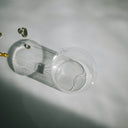When it comes to treating hair loss, finasteride stands as one of the most commonly prescribed medications worldwide. Originally developed to treat prostate conditions, this medication found its way into hair loss treatment protocols when researchers noticed an unexpected side effect: hair regrowth. Today, millions of men rely on finasteride to maintain their hair. However, some users report a concerning phenomenon – initial hair shedding after starting treatment. This has led to confusion and anxiety among many people considering or currently taking this medication.
Table of content
Can Finasteride Cause Hair Loss?
Yes, finasteride can cause temporary hair loss during the first few months of treatment, commonly known as "shedding" or "initial shedding phase." This paradoxical hair loss occurs as the medication accelerates the hair growth cycle, pushing weak hairs into the shedding phase more quickly to make way for healthier hair. This temporary increase in hair loss typically resolves within 2-3 months and is actually a sign that the medication is working. Long-term finasteride use does not cause permanent hair loss; instead, it prevents hair loss in most users by blocking the hormone (DHT) responsible for male pattern baldness.
As your leading source for hair health information over the past 4 years, we never compromise on accuracy. When it comes to your health, you deserve information you can truly rely on - and earning your trust is our top priority.
Here's how Scandinavian Biolabs ensures every piece of content meets the highest standards of accuracy and integrity:
- Credentialed Experts: Our reviewers are actively practicing doctors and medical researchers
- Stringent Reviews: Content undergoes rigorous editing by subject specialists and review by a practicing doctor.
- Evidence-Based: We rely on well-established research from trusted scientific sources like peer-reviewed journals and health authorities.
- Full Transparency: Our editorial standards, writer credentials, reviewer credentials, correction process, and funding are all publicly documented.
- Independent Voice: While we do promote products, we operate in a vacuum to business operations. Our main goal is just an unwavering commitment to providing medically-sound guidance.
You can count on Scandinavian Biolabs to consistently deliver the trustworthy health information you deserve. Read our Editorial Standards.
Understanding How Finasteride Works
To comprehend why finasteride might initially cause more hair to fall out before ultimately helping with hair retention, it's important to understand the medication's mechanism of action and how it interacts with the normal hair growth cycle.
The Science Behind Finasteride
Finasteride belongs to a class of medications called 5-alpha-reductase inhibitors. Its primary action is blocking the enzyme 5-alpha-reductase, which is responsible for converting testosterone into dihydrotestosterone (DHT). In genetically predisposed individuals, DHT is the main culprit behind androgenetic alopecia, commonly known as male pattern baldness.
When DHT binds to receptors in hair follicles, it triggers a process called miniaturization. During miniaturization:
- Hair follicles gradually shrink
- Growth (anagen) phase shortens
- Hairs become progressively thinner
- Eventually, follicles produce only fine, unpigmented vellus hairs or stop producing hair altogether
By inhibiting the production of DHT, finasteride:
- Reduces DHT levels by approximately 65-70% in the scalp
- Halts or slows the miniaturization process
- Allows some miniaturized follicles to recover and produce thicker, stronger terminal hairs
- Prevents further progression of pattern hair loss
The Normal Hair Growth Cycle
Each hair on your head goes through a continuous cycle consisting of three main phases:
- Anagen (Growth Phase): Lasting 2-7 years, this is when active growth occurs. At any given time, about 85-90% of your scalp hairs are in this phase.
- Catagen (Transition Phase): A brief 2-3 week period when growth stops and the follicle shrinks.
- Telogen (Resting Phase): Lasting 2-4 months, the old hair rests while a new hair begins to form below it. Eventually, the old hair falls out as the new one pushes it out.
Under normal conditions, we lose about 50-100 telogen hairs daily. This natural shedding is barely noticeable because it's balanced by new growth.
The Finasteride Shedding Phenomenon Explained
When someone starts taking finasteride, the medication can trigger a process that temporarily disrupts the normal hair cycle.
Why Initial Shedding Occurs
Several mechanisms contribute to the initial hair shedding observed with finasteride:
- Synchronization of Hair Cycles: Finasteride can cause many hair follicles to synchronize their growth cycles. This means that weaker, DHT-affected hairs that were already destined to fall out may enter the shedding phase simultaneously rather than gradually.
- Accelerated Transition: Some research suggests finasteride may accelerate the transition of weak, miniaturized hairs from the growth phase to the shedding phase, making room for potentially stronger hairs to develop.
- Hormonal Adjustment: The sudden decrease in DHT levels represents a significant hormonal change for hair follicles, which may respond by shedding existing hairs as they adjust to the new hormonal environment.
Characteristics of Finasteride Shedding
Finasteride-induced shedding typically has these characteristics:
- Begins within 2-8 weeks after starting treatment
- Usually lasts 2-3 months before subsiding
- Primarily affects the areas already experiencing pattern hair loss
- Involves both miniaturized and some terminal hairs
- Shedding is diffuse rather than patchy
- Resolves on its own without intervention if treatment is continued
This temporary increase in hair fall often causes alarm among users who expect immediate improvement rather than apparent worsening of their condition. However, dermatologists typically recognize this as a positive sign that the medication is affecting the hair follicles.
Clinical Evidence on Finasteride and Shedding
The phenomenon of initial shedding with finasteride has been observed clinically, though it wasn't extensively documented in the original clinical trials.
Research Findings
Key studies that provide insight into finasteride-related shedding include:
- The original phase III clinical trials of finasteride for male pattern baldness did not specifically measure initial shedding but did document that maximum improvement was typically not seen until 1-2 years of continuous use.
- Observational studies from dermatology practices estimate that approximately 10-15% of finasteride users experience noticeable initial shedding.
- A retrospective analysis published in the Journal of Dermatological Treatment noted that patients who experienced initial shedding often showed better long-term results, suggesting it may predict a stronger response to the medication.
It's important to note that the temporary nature of this shedding has been consistently observed, with virtually all cases resolving within 2-4 months while continuing treatment.
Distinguishing Finasteride Shedding from Other Causes
Not all hair loss during finasteride treatment is necessarily due to the medication's shedding effect. Other possible causes include:
- Continued progression of androgenetic alopecia: Finasteride reduces DHT by about 70%, not 100%, so some continued miniaturization may occur.
- Telogen effluvium: Stress, illness, nutritional deficiencies, or other medications can trigger this type of temporary shedding.
- Seasonal shedding: Many people naturally lose more hair during certain seasons, particularly fall.
- Other hair loss disorders: Conditions like alopecia areata, which causes patchy hair loss, can coincidentally develop during finasteride treatment.
Finasteride's Long-Term Effects on Hair
Beyond the initial shedding period, what can users expect from finasteride in the long run?
Expected Timeline of Results
Based on clinical studies and real-world experience, the typical progression of finasteride treatment follows this pattern:
- 0-3 months: Possible initial shedding; no visible improvements yet
- 3-6 months: Shedding typically stops; hair loss stabilization begins
- 6-12 months: Some users notice thickening of existing hairs and modest regrowth
- 1-2 years: Maximum benefits usually achieved by this point
- Beyond 2 years: Continued treatment maintains results; discontinuation leads to reversal of gains
Long-Term Efficacy Data
Long-term studies of finasteride for hair loss have shown:
- Approximately 83% of men maintain their hair count over 5 years (compared to significant loss in placebo groups)
- About 65% experience some degree of regrowth
- The medication remains effective for many years with continued use
- Benefits are lost within 6-12 months of discontinuation
This data confirms that while finasteride may cause temporary shedding initially, its long-term effect is strongly protective against further hair loss.
Managing Finasteride-Induced Shedding
For those experiencing the anxiety of increased hair fall after starting finasteride, several strategies can help navigate this temporary phase.
Medical Approaches
Dermatologists may recommend these approaches:
- Continue treatment: The most important step is to continue finasteride as prescribed. Discontinuing during the shedding phase means enduring the shedding without gaining the eventual benefits.
- Consider combination therapy: Some physicians prescribe topical minoxidil (Rogaine) alongside finasteride. Minoxidil works through different mechanisms and may help counterbalance the temporary shedding effect.
- Adjust dosing schedule: In rare cases of severe shedding, doctors might recommend a gradual dose escalation rather than starting with the full dose immediately.
- Rule out other causes: A dermatologist can help determine if the hair loss is consistent with temporary finasteride shedding or if other factors might be involved.
Practical and Psychological Support
Beyond medical management, these strategies can help cope with the temporary shedding phase:
- Documentation: Take dated photos of your hair under consistent lighting conditions to objectively track changes over time.
- Styling adjustments: Volumizing products, different styling techniques, or even temporary concealing products can help mask the visual effects of shedding.
- Maintain perspective: Remember that this phase is temporary and paradoxically may indicate the treatment is working.
- Seek support: Online forums for hair loss patients can provide emotional support and reassurance from others who have experienced the same journey.
Frequently Asked Questions About Finasteride and Hair Loss
Is finasteride shedding a sign the medication isn't working?
No, in fact, it's often the opposite. Initial shedding typically indicates that finasteride is affecting your hair follicles and may predict a good long-term response to treatment. Most dermatologists consider this a positive sign that the medication is active in your system.
How much shedding is normal with finasteride?
The amount varies considerably between individuals. Some notice only a slight increase in daily hair fall, while others may experience more dramatic shedding. The key factor is that it should be temporary, typically resolving within 2-3 months.
Can finasteride cause permanent hair loss?
There is no evidence that finasteride causes permanent hair loss. The medication is FDA-approved specifically to prevent hair loss, and long-term studies show it's effective for this purpose in the vast majority of users.
What if shedding continues beyond 3-4 months?
Persistent shedding beyond the typical initial phase warrants consultation with a dermatologist. This could indicate that:
- Another form of hair loss is present
- The dosage may need adjustment
- Additional treatments might be beneficial
Does finasteride work for all types of hair loss?
No. Finasteride is specifically effective for androgenetic alopecia (male pattern baldness). It does not treat:
- Telogen effluvium (stress-related shedding)
- Alopecia areata (an autoimmune condition)
- Scarring alopecias
- Hair loss due to nutritional deficiencies
This specificity is why proper diagnosis is essential before starting treatment.
Conclusion
The question "Can finasteride cause hair loss?" has a somewhat paradoxical answer. While finasteride can indeed cause temporary shedding in the first few months of treatment, this transient increase in hair fall actually signals the medication's effectiveness and typically precedes long-term hair retention and possible regrowth.
Understanding this phenomenon can help patients manage expectations and stay the course through the initial treatment phase. The scientific evidence strongly supports finasteride's overall effectiveness in preventing further hair loss for most men with androgenetic alopecia, despite the counterintuitive initial shedding some experience.
For those considering or currently using finasteride, patience is key. The temporary shedding phase represents a transition period as the medication begins to alter the hair growth cycle and reduce the damaging effects of DHT on susceptible follicles. With continued use, this phase resolves, typically yielding to the medication's intended benefits of maintaining existing hair and potentially regrowing miniaturized follicles.
As with any medication, individual results may vary, and consultation with a dermatologist specializing in hair disorders provides the best guidance for your specific situation. When used appropriately under medical supervision, finasteride remains one of the most effective treatments available for male pattern hair loss, despite the temporary shedding that some users experience.
Tired of Thinning Hair? Try a Clinically Tested Serum.
Looking for a natural way to regrow hair and achieve a thicker, fuller head of hair? Ditch the stinging nettle for hair loss – Bio-Pilixin Serum is a drug-free hair activation serum that delivers clinically tested results.
Here's why Bio-Pilixin is superior:
- Clinically Tested Results: 93% of users saw a reduction in hair loss, and 73% experienced increased hair density.
- Safe and Natural: Unlike harsh chemicals, Bio-Pilixin uses plant growth factors derived from stem cell technology to nourish hair follicles and stimulate growth.
- Fast-Acting: See visible results in as little as 45 days (most typically see results within 150 days).
Stop wasting time on unproven remedies. Bio-Pilixin is the safe, natural serum you've been searching for.
Read more:






